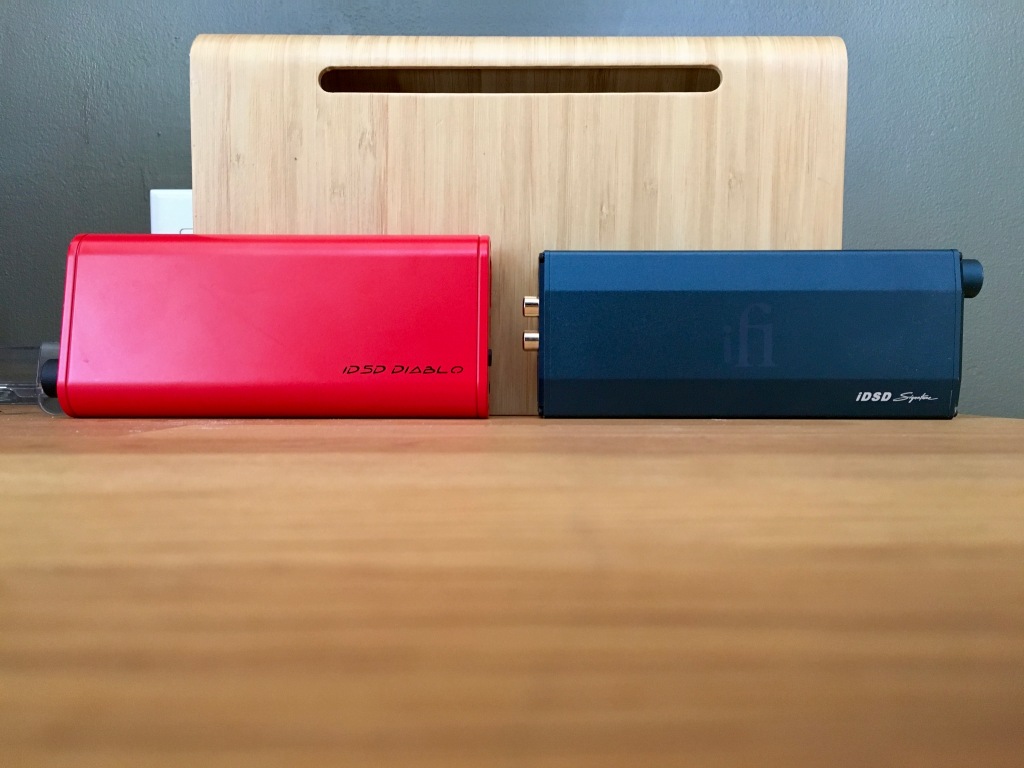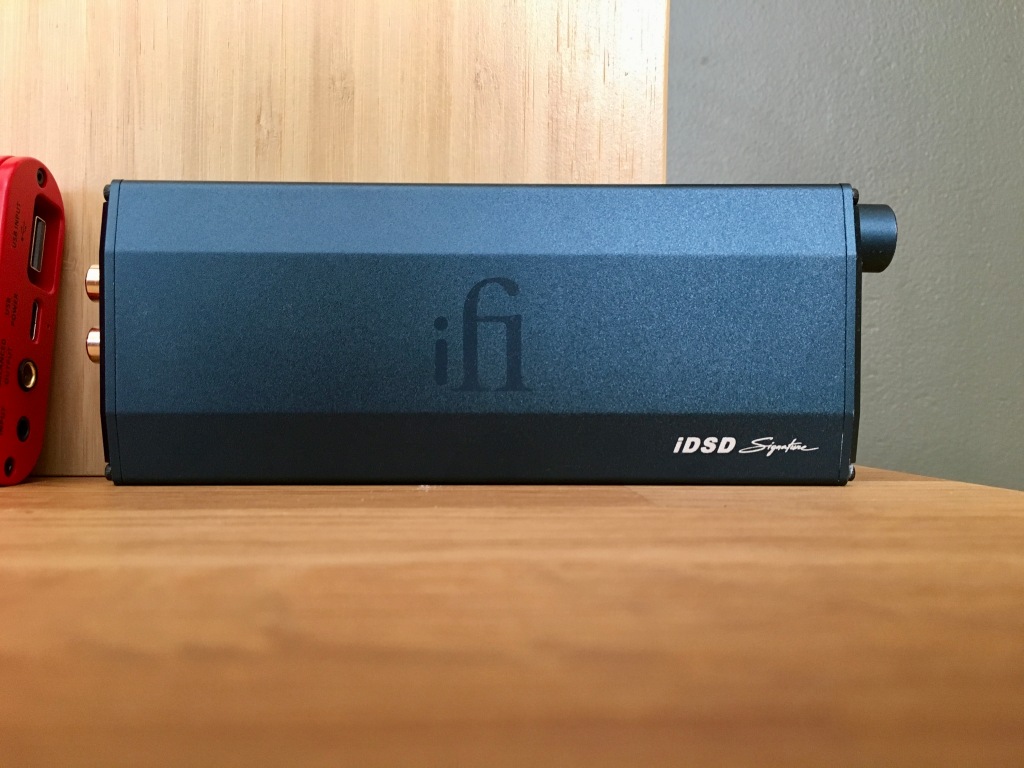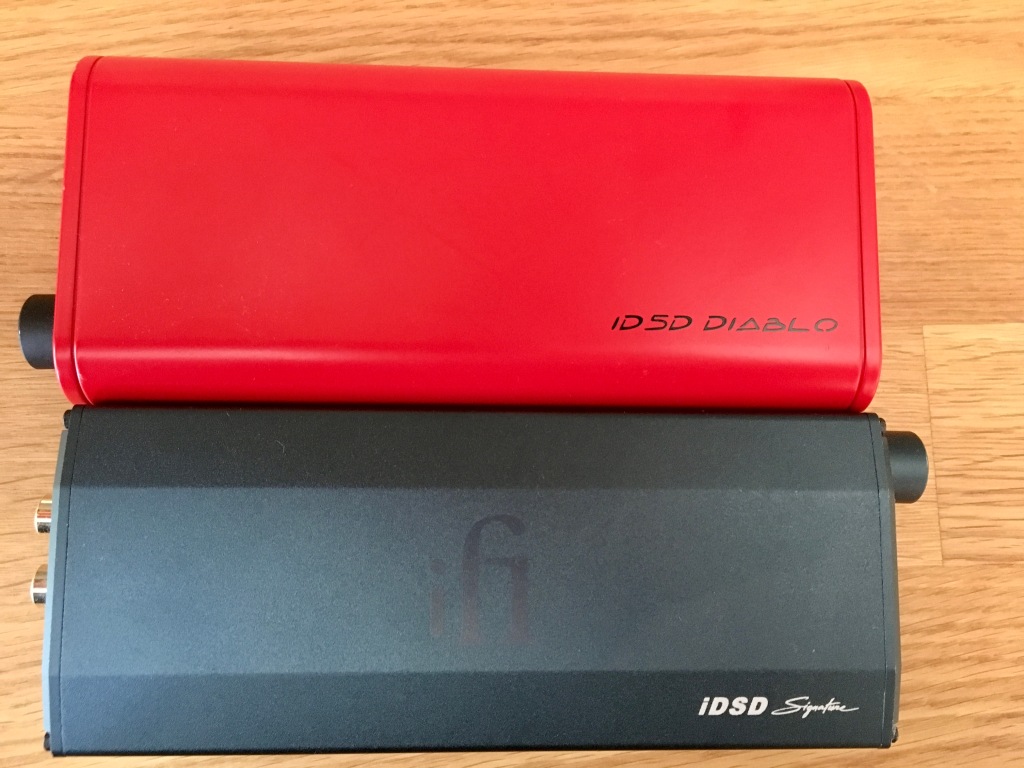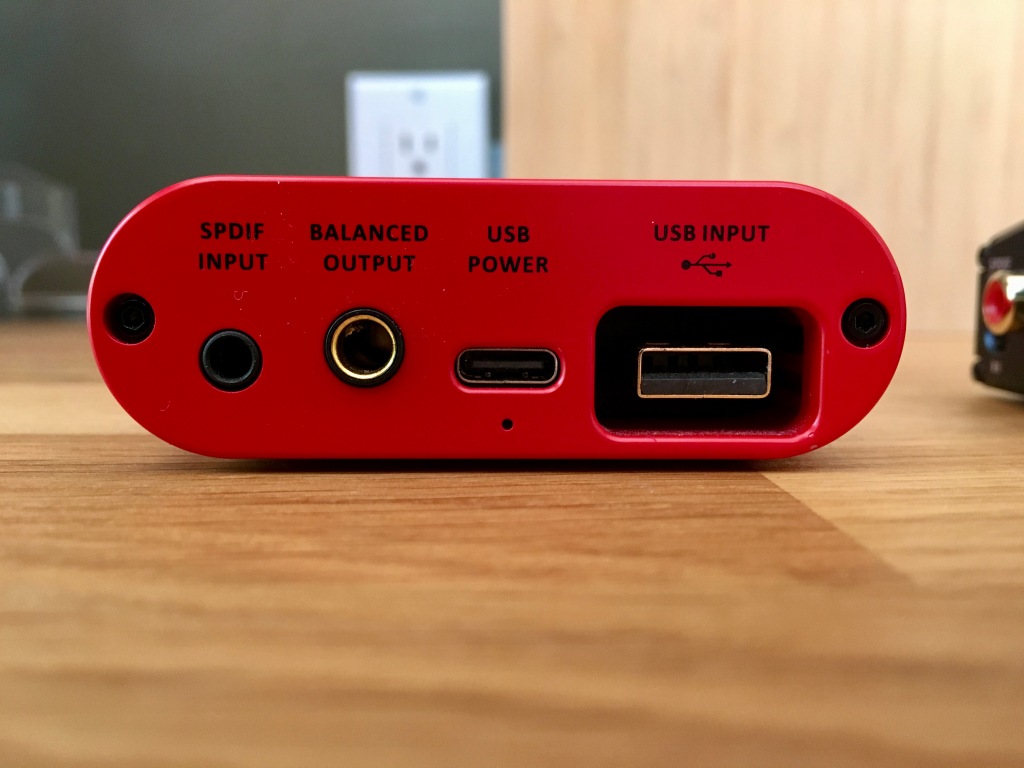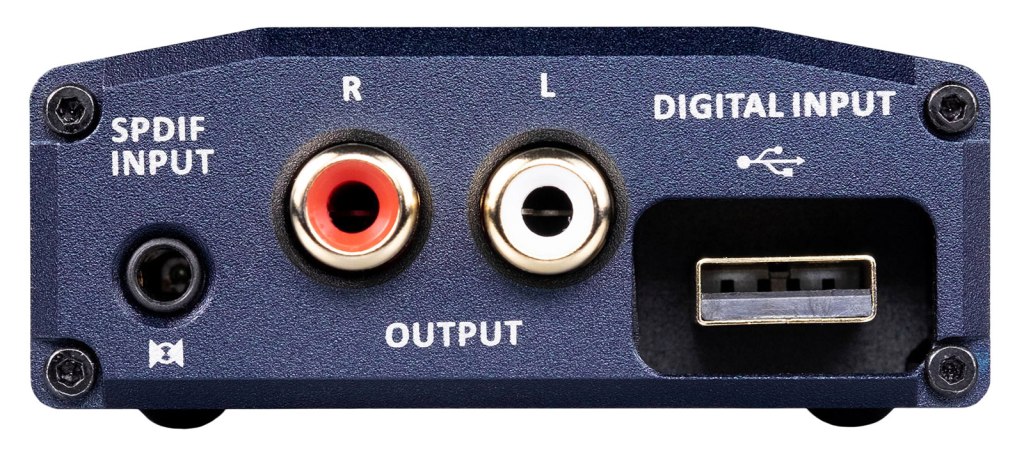General Information
iFi ushers in the New Year with the best battery-powered DAC/headphone amp the company has ever produced – the devilishly brilliant iDSD Diablo. Engineered to sit proudly at the top of iFi’s illustrious range of mobile and transportable devices, the Diablo is built for the purists – the true headphone enthusiasts who crave pure, unadulterated sonic performance.
With dimensions of 166x72x25mm, its size is similar to DAC/amps in iFi’s long-running, transportable micro iDSD series, with a built-in, quick-charge-compatible battery that makes it easy to move from desk to living room to travel bag. Its sleek new design and fiery red finish, however, mark it out as distinctly different.
Like a high-performance sports car designed for uncompromising speed, the iDSD Diablo sets aside facilities offered by other iFi DAC/headphone amps – sonic tailoring options and Bluetooth connectivity, for example – to focus on pure sonic power, featuring ultra-high-quality circuit components and the ability to drive any headphones on the planet with aplomb. Simply connect your digital source via USB or S/PDIF, plug in your headphones and prepare for a riveting musical ride from this elite-class digital audio engine, expertly tuned to achieve captivating speed, scale and dynamic range.
DAC’s entertainment
The iDSD Diablo’s digital stage incorporates a Burr-Brown DAC chip that iFi uses extensively, selected for its natural-sounding ‘musicality’ and True Native architecture. Here, two of these chips are installed in a custom ‘interleaved’ configuration – this enables four pairs of differential signals (two pairs per channel) which lowers the noise floor, improves channel separation and enhances the DAC’s ability to resolve fine musical detail and micro-dynamics.
iFi’s experience with this Burr-Brown chipset means it knows how to make the most of it, but the creation of an exemplary digital stage involves more than the selection of a particular DAC chip. One such critical component is the XMOS chip that processes the audio data received via the USB and S/PDIF digital inputs. The iDSD Diablo uses a new low-latency XMOS microcontroller with greatly enhanced processing power – compared to the current generation of eight-core chips, this new 16-core IC delivers double the clock speed (2000MIPS) and four times the memory.

iFi’s in-house digital development team has programmed the XMOS firmware to optimise sound quality and ensure a perfect partnership with the DAC circuitry. Extensive jitter-eradication technologies are also applied to the digital stage, including an enhanced version of iFi’s GMT (Global Master Timing) femto-precision clock featuring a new crystal oscillator.
Every music format at the highest quality
Hi-res audio support is state-of-the-art, handling PCM data to 32-bit/768kHz, all levels of DSD up to DSD512, and single- and double-speed DXD.
Thanks to the Burr-Brown DAC chip’s four-channel True Native design, PCM and DSD take separate pathways – this enables DSD, as well as PCM, to remain ‘bit-perfect’ in its native form right through to analogue conversion. This is often not the case with DAC devices from other brands – even if DSD compatibility is stated, many such DACs convert DSD signals to PCM.
MQA – the hi-res streaming codec, as used by Tidal’s ‘Masters’ tier – is also supported through the USB and S/PDIF inputs, with full decoding of MQA files up to 384kHz thanks to the processing power of the new 16-core XMOS chip. This means that the full ‘three unfold’ decoding process is performed internally, as opposed to only the final unfold in the manner of an MQA ‘renderer’. Globally, MQA has become an important consideration for any comprehensively equipped DAC; for Tidal Masters subscribers, the iDSD Diablo is a great way to make the most of the superior sound of which this streaming service is capable.
PureWave – balanced circuit design for the purest sound
The digital stage is only half the story in any DAC/headphone amp; when it comes to the crucial analogue circuitry, many such devices fall short. Balanced, differential analogue circuit design has long been championed for its ability to reduce noise and cross-talk within the signal path by fully separating the left and right channels. However, this is more complex and costly than single-ended circuitry, and so has traditionally remained the preserve of high-end hi-fi components.

iFi has gradually introduced fully balanced circuit design across its range – first in the flagship Pro Series components, then in the entry-level ZEN Series devices. The company’s two newest DACs, the mains-powered NEO iDSD and transportable iDSD Diablo, benefit from further refinement of their balanced, symmetrical dual-mono topologies with short, direct signal paths. iFi calls this circuit concept ‘PureWave’, referring to the sonic purity it achieves thanks to exceptional linearity and infinitesimally low levels of noise and distortion.
Powerful amplification delivers musical gratification
Already renowned for the performance of the amp stages in its DAC/headphone amps, iFi has ensured the iDSD Diablo is its best-ever transportable amplifier, designed to deliver reference-level sound. Able to drive all manner of headphones with ease, from highly sensitive in-ear monitors to current-hungry planar headphones, it delivers prodigious power (up to 5000mW), propulsive energy and engaging dynamics, coupled to a remarkable ability to resolve fine texture and detail.
The great variation in the electrical characteristics of different headphone/earphone types is accommodated by the provision of three settings enabling the user to adjust power and gain to suit whatever the amp stage is tasked with driving: ‘Turbo’ ramps up the level of drive for current-hungry headphones, ‘Eco’ dials down the power to suit high-sensitivity in-ear monitors and/or extend battery life, and ‘Normal’ sits between the two.

High-quality components are used throughout the iDSD Diablo’s circuitry, utilising its larger form factor in comparison to smaller, pocket-sized DAC/amps. Custom ultra-low-distortion MOSFET op-amps feature in both the digital and analogue stages, together with a hand-selected range of capacitors including the multilayer ceramic type TDK C0G and aluminium-polymer type Panasonic OS-CON. MELF thin-film resistors and inductors from Taiyo Yuden and Murata also feature in the circuit design.
These are all more costly than commonly used circuit components, but class-leading qualities such as low ESR (Equivalent Series Resistance), high stability and low distortion pay great dividends in terms of sound quality. Many hours of listening tests, alongside rigorous analysis in the lab, has determined the optimum circuit design to deliver maximum musical enjoyment.
An important aspect of the iDSD Diablo’s circuit design is its direct-coupled nature (no coupling capacitor is present), achieved without a conventionally applied DC servo; iFi calls this design Servoless Direct Drive. Also important is the use of a high-quality analogue potentiometer to control volume – its sonic transparency compared to chip-based volume controls makes the most of the clarity and resolution of the amp stage.
OptimaLoop – negative feedback that is purely positive
‘Negative feedback’ is used in amplifier circuits to compare the output signal with the input signal and correct errors, in order to control gain and reduce distortion. For sound quality, this is positive; but commonly applied, one-size-fits-all ‘global negative feedback’ can highlight different problems whilst solving others – corruption of the error signal, phase shifts, group delay and so on can all have a negative impact on sound quality.
Recognising that different parts of a circuit benefit from specifically optimised feedback loops, iFi has developed a negative feedback system that is much more accurate than the usual approach. This incorporates multiple feedback paths instead of one global loop, each path optimised for a particular function and working synergistically with the others to deliver optimal overall performance. iFi calls this new configuration OptimaLoop.
This power does not corrupt
In keeping with the iDSD Diablo’s focus on pure, unadulterated performance, much attention has been applied to the power supply circuity. Battery power provides a theoretical performance advantage over mains power, with ultra-clean and stable DC current avoiding the issues that can be introduced by mains electricity with its dips, spikes and noise-inducing RFI/EMI pollution. There are also potential sonic downsides to battery power, however, resulting from low output voltage and inconsistent output impedance as batteries discharge – these issues are fully tackled by the iDSD Diablo’s design.
In order to make less efficient headphone types sing – planar magnetic designs, for example – the voltage needs to be stepped up from 3.7V to +/- 15V. This is achieved through the use of a step-up converter running at 1.2MHz – a frequency far beyond audibility that is easier to filter than a typical switch-mode supply, enabling high linearity and ultra-low noise.

High-bandwidth power supply circuity is dedicated to each critical part of the iDSD Diablo’s design, with independent linear regulation delivering excellent PSRR (Power Supply Rejection Ratio) performance. The headphone amp stage eschews IC regulators in favour of Panasonic OS-CON capacitors, delivering 2320uF between them. The DAC section benefits from an ultra-low-noise regulator with additional passive filtering, reducing high order harmonic distortion and, in turn, jitter. Even the USB input stage benefits from dedicated regulation and multistage filtering, and the microprocessor control circuitry (often a local source of digital noise) has separate regulation, too.
Get connected
At the front of the unit, alongside a standard 6.3mm single-ended headphone socket, resides a 4.4mm Pentaconn output for headphones offering balanced connection. An increasing number of high-quality headphones and in-ear monitors either come so equipped or give the option of detaching the cable and upgrading to a 4.4mm Pentaconn connector (this output is particularly recommended for tougher headphone loads). In terms of power, the balanced headphone output delivers 12.6V/4980mW into 32 ohms and 19.2V/611mW into 600 ohms, while the single-ended output supplies 8.8V/2417mW into 32 ohms and 9.6V/153mW into 600 ohms.
At the back of the chassis are two digital audio inputs: USB-A and an S/PDIF socket that accepts both electrical and optical signals, the former via a 3.5mm connector and the latter via a supplied adapter. Unusually, the USB-A input features a ‘male’ connector, rather than a typical ‘female’ port – this arrangement provides greater mechanical integrity than the USB/Micro USB ports commonly used by other DAC/headphone amps. It also offers an advantage to users of iPhones and iPads with Lightning ports, because it accepts Apple’s Lightning to USB Camera Adapter directly without requiring an additional female-to-male USB adaptor. A separate USB-C charging port is also provided, along with a fixed line-level 4.4mm Pentaconn balanced output to connect an external amp.
A package worthy of reference status
In keeping with a reference-level product, iFi has been generous with the accessories supplied with the iDSD Diablo. The DAC/amp may be powered from the mains, as well as by its built-in battery; in order to ensure optimal sound quality when hooked up to the mains, iFi includes its iPower 5V AC/DC adapter, which engenders significantly less noise than other similar devices thanks to Active Noise Cancellation and sells separately for £49.
Also included is a 4.4mm Pentaconn to XLR balanced interconnect cable, enabling the iDSD Diablo to be connected to an amp and speakers (or a pair of active speakers) with balanced XLR inputs. Other supplied connectors include a short (15cm) USB-C to USB-A audio cable, as well as an extension cable – all USB3.0 compliant – plus a USB-C charging cable and an adapter to connect headphones with a 3.5mm jack to the 6.3mm single-ended output. Even a travel case is included.
In addition, the first iDSD Diablo production run includes iFi’s iPurifier3 in the bundle – retailing separately at £129, this USB ‘noise-buster’ is designed to tackle all aspects that degrade sound quality over USB thanks to a precision mix of tech including Active Noise Cancellation. It all adds up to a package of accessories worth around £300.
Delivering devilishly good sound for headphone lovers, iFi’s iDSD Diablo is available from selected retailers from Friday 15th January at an RRP of £899, (€999, $899).
With dimensions of 166x72x25mm, its size is similar to DAC/amps in iFi’s long-running, transportable micro iDSD series, with a built-in, quick-charge-compatible battery that makes it easy to move from desk to living room to travel bag. Its sleek new design and fiery red finish, however, mark it out as distinctly different.
Like a high-performance sports car designed for uncompromising speed, the iDSD Diablo sets aside facilities offered by other iFi DAC/headphone amps – sonic tailoring options and Bluetooth connectivity, for example – to focus on pure sonic power, featuring ultra-high-quality circuit components and the ability to drive any headphones on the planet with aplomb. Simply connect your digital source via USB or S/PDIF, plug in your headphones and prepare for a riveting musical ride from this elite-class digital audio engine, expertly tuned to achieve captivating speed, scale and dynamic range.
DAC’s entertainment
The iDSD Diablo’s digital stage incorporates a Burr-Brown DAC chip that iFi uses extensively, selected for its natural-sounding ‘musicality’ and True Native architecture. Here, two of these chips are installed in a custom ‘interleaved’ configuration – this enables four pairs of differential signals (two pairs per channel) which lowers the noise floor, improves channel separation and enhances the DAC’s ability to resolve fine musical detail and micro-dynamics.
iFi’s experience with this Burr-Brown chipset means it knows how to make the most of it, but the creation of an exemplary digital stage involves more than the selection of a particular DAC chip. One such critical component is the XMOS chip that processes the audio data received via the USB and S/PDIF digital inputs. The iDSD Diablo uses a new low-latency XMOS microcontroller with greatly enhanced processing power – compared to the current generation of eight-core chips, this new 16-core IC delivers double the clock speed (2000MIPS) and four times the memory.

iFi’s in-house digital development team has programmed the XMOS firmware to optimise sound quality and ensure a perfect partnership with the DAC circuitry. Extensive jitter-eradication technologies are also applied to the digital stage, including an enhanced version of iFi’s GMT (Global Master Timing) femto-precision clock featuring a new crystal oscillator.
Every music format at the highest quality
Hi-res audio support is state-of-the-art, handling PCM data to 32-bit/768kHz, all levels of DSD up to DSD512, and single- and double-speed DXD.
Thanks to the Burr-Brown DAC chip’s four-channel True Native design, PCM and DSD take separate pathways – this enables DSD, as well as PCM, to remain ‘bit-perfect’ in its native form right through to analogue conversion. This is often not the case with DAC devices from other brands – even if DSD compatibility is stated, many such DACs convert DSD signals to PCM.
MQA – the hi-res streaming codec, as used by Tidal’s ‘Masters’ tier – is also supported through the USB and S/PDIF inputs, with full decoding of MQA files up to 384kHz thanks to the processing power of the new 16-core XMOS chip. This means that the full ‘three unfold’ decoding process is performed internally, as opposed to only the final unfold in the manner of an MQA ‘renderer’. Globally, MQA has become an important consideration for any comprehensively equipped DAC; for Tidal Masters subscribers, the iDSD Diablo is a great way to make the most of the superior sound of which this streaming service is capable.
PureWave – balanced circuit design for the purest sound
The digital stage is only half the story in any DAC/headphone amp; when it comes to the crucial analogue circuitry, many such devices fall short. Balanced, differential analogue circuit design has long been championed for its ability to reduce noise and cross-talk within the signal path by fully separating the left and right channels. However, this is more complex and costly than single-ended circuitry, and so has traditionally remained the preserve of high-end hi-fi components.

iFi has gradually introduced fully balanced circuit design across its range – first in the flagship Pro Series components, then in the entry-level ZEN Series devices. The company’s two newest DACs, the mains-powered NEO iDSD and transportable iDSD Diablo, benefit from further refinement of their balanced, symmetrical dual-mono topologies with short, direct signal paths. iFi calls this circuit concept ‘PureWave’, referring to the sonic purity it achieves thanks to exceptional linearity and infinitesimally low levels of noise and distortion.
Powerful amplification delivers musical gratification
Already renowned for the performance of the amp stages in its DAC/headphone amps, iFi has ensured the iDSD Diablo is its best-ever transportable amplifier, designed to deliver reference-level sound. Able to drive all manner of headphones with ease, from highly sensitive in-ear monitors to current-hungry planar headphones, it delivers prodigious power (up to 5000mW), propulsive energy and engaging dynamics, coupled to a remarkable ability to resolve fine texture and detail.
The great variation in the electrical characteristics of different headphone/earphone types is accommodated by the provision of three settings enabling the user to adjust power and gain to suit whatever the amp stage is tasked with driving: ‘Turbo’ ramps up the level of drive for current-hungry headphones, ‘Eco’ dials down the power to suit high-sensitivity in-ear monitors and/or extend battery life, and ‘Normal’ sits between the two.

High-quality components are used throughout the iDSD Diablo’s circuitry, utilising its larger form factor in comparison to smaller, pocket-sized DAC/amps. Custom ultra-low-distortion MOSFET op-amps feature in both the digital and analogue stages, together with a hand-selected range of capacitors including the multilayer ceramic type TDK C0G and aluminium-polymer type Panasonic OS-CON. MELF thin-film resistors and inductors from Taiyo Yuden and Murata also feature in the circuit design.
These are all more costly than commonly used circuit components, but class-leading qualities such as low ESR (Equivalent Series Resistance), high stability and low distortion pay great dividends in terms of sound quality. Many hours of listening tests, alongside rigorous analysis in the lab, has determined the optimum circuit design to deliver maximum musical enjoyment.
An important aspect of the iDSD Diablo’s circuit design is its direct-coupled nature (no coupling capacitor is present), achieved without a conventionally applied DC servo; iFi calls this design Servoless Direct Drive. Also important is the use of a high-quality analogue potentiometer to control volume – its sonic transparency compared to chip-based volume controls makes the most of the clarity and resolution of the amp stage.
OptimaLoop – negative feedback that is purely positive
‘Negative feedback’ is used in amplifier circuits to compare the output signal with the input signal and correct errors, in order to control gain and reduce distortion. For sound quality, this is positive; but commonly applied, one-size-fits-all ‘global negative feedback’ can highlight different problems whilst solving others – corruption of the error signal, phase shifts, group delay and so on can all have a negative impact on sound quality.
Recognising that different parts of a circuit benefit from specifically optimised feedback loops, iFi has developed a negative feedback system that is much more accurate than the usual approach. This incorporates multiple feedback paths instead of one global loop, each path optimised for a particular function and working synergistically with the others to deliver optimal overall performance. iFi calls this new configuration OptimaLoop.
This power does not corrupt
In keeping with the iDSD Diablo’s focus on pure, unadulterated performance, much attention has been applied to the power supply circuity. Battery power provides a theoretical performance advantage over mains power, with ultra-clean and stable DC current avoiding the issues that can be introduced by mains electricity with its dips, spikes and noise-inducing RFI/EMI pollution. There are also potential sonic downsides to battery power, however, resulting from low output voltage and inconsistent output impedance as batteries discharge – these issues are fully tackled by the iDSD Diablo’s design.
In order to make less efficient headphone types sing – planar magnetic designs, for example – the voltage needs to be stepped up from 3.7V to +/- 15V. This is achieved through the use of a step-up converter running at 1.2MHz – a frequency far beyond audibility that is easier to filter than a typical switch-mode supply, enabling high linearity and ultra-low noise.

High-bandwidth power supply circuity is dedicated to each critical part of the iDSD Diablo’s design, with independent linear regulation delivering excellent PSRR (Power Supply Rejection Ratio) performance. The headphone amp stage eschews IC regulators in favour of Panasonic OS-CON capacitors, delivering 2320uF between them. The DAC section benefits from an ultra-low-noise regulator with additional passive filtering, reducing high order harmonic distortion and, in turn, jitter. Even the USB input stage benefits from dedicated regulation and multistage filtering, and the microprocessor control circuitry (often a local source of digital noise) has separate regulation, too.
Get connected
At the front of the unit, alongside a standard 6.3mm single-ended headphone socket, resides a 4.4mm Pentaconn output for headphones offering balanced connection. An increasing number of high-quality headphones and in-ear monitors either come so equipped or give the option of detaching the cable and upgrading to a 4.4mm Pentaconn connector (this output is particularly recommended for tougher headphone loads). In terms of power, the balanced headphone output delivers 12.6V/4980mW into 32 ohms and 19.2V/611mW into 600 ohms, while the single-ended output supplies 8.8V/2417mW into 32 ohms and 9.6V/153mW into 600 ohms.
At the back of the chassis are two digital audio inputs: USB-A and an S/PDIF socket that accepts both electrical and optical signals, the former via a 3.5mm connector and the latter via a supplied adapter. Unusually, the USB-A input features a ‘male’ connector, rather than a typical ‘female’ port – this arrangement provides greater mechanical integrity than the USB/Micro USB ports commonly used by other DAC/headphone amps. It also offers an advantage to users of iPhones and iPads with Lightning ports, because it accepts Apple’s Lightning to USB Camera Adapter directly without requiring an additional female-to-male USB adaptor. A separate USB-C charging port is also provided, along with a fixed line-level 4.4mm Pentaconn balanced output to connect an external amp.
A package worthy of reference status
In keeping with a reference-level product, iFi has been generous with the accessories supplied with the iDSD Diablo. The DAC/amp may be powered from the mains, as well as by its built-in battery; in order to ensure optimal sound quality when hooked up to the mains, iFi includes its iPower 5V AC/DC adapter, which engenders significantly less noise than other similar devices thanks to Active Noise Cancellation and sells separately for £49.
Also included is a 4.4mm Pentaconn to XLR balanced interconnect cable, enabling the iDSD Diablo to be connected to an amp and speakers (or a pair of active speakers) with balanced XLR inputs. Other supplied connectors include a short (15cm) USB-C to USB-A audio cable, as well as an extension cable – all USB3.0 compliant – plus a USB-C charging cable and an adapter to connect headphones with a 3.5mm jack to the 6.3mm single-ended output. Even a travel case is included.
In addition, the first iDSD Diablo production run includes iFi’s iPurifier3 in the bundle – retailing separately at £129, this USB ‘noise-buster’ is designed to tackle all aspects that degrade sound quality over USB thanks to a precision mix of tech including Active Noise Cancellation. It all adds up to a package of accessories worth around £300.
Delivering devilishly good sound for headphone lovers, iFi’s iDSD Diablo is available from selected retailers from Friday 15th January at an RRP of £899, (€999, $899).
























